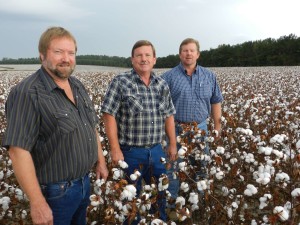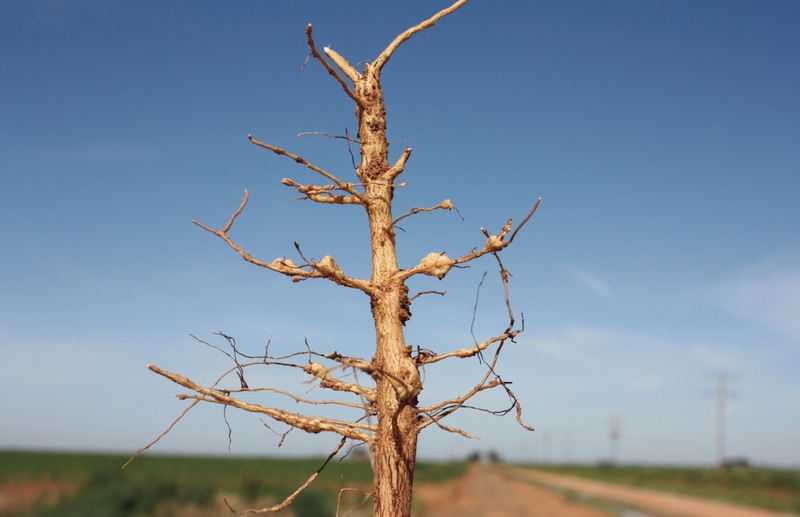Florida Brothers Focus on Yield and Weeds

Nestled into the north Florida landscape near the Georgia and Alabama state lines, 3J Farms provides the kind of picturesque scenery that belongs on postcards. Dense pine forests provide the framework for gently rolling fields that, during mid- to late- October are filled with showy white cotton.
As the Jordan brothers can attest, though, those fields haven’t always been so showy. Brothers Mike, Steve and John have been farming this ground long enough to remember when high yields weren’t always a possibility. More accurately, they remember a time when the phrase “high yields” meant much smaller numbers than it means today.
The Jordans farm sandy soils that can occasionally create problems. What’s more, their operation, located near Malone, FL, isn’t far from the Georgia county where glyphosate resistant Palmer amaranth was first discovered. Such is life for cotton growers in the Florida Panhandle, though.
“We’re in the very Northeast corner of Florida,” says Mike, the oldest brother. “Half a mile in one direction is Alabama. About three miles the other way is Georgia. There are a lot of challenges to growing cotton in this area, but there are some advantages too.”
Glass Half Full
Because they are so far south, a long growing season allows the brothers to double-crop, often planting their cotton after harvesting cucumbers from their fields. A cucumber to cotton double-crop often calls for the brothers to plant cotton as late as the middle of June. They don’t sacrifice anything in yields due to the shorter season, thanks to some management tricks they’ve picked up over the years.
“We’re normally finishing planting around the end of June,” says Mike. “We plant Deltapine DP 1034 B2RF and DP 1028 B2RF behind the cucumbers, which is kind of unusual around here. When we first told them we wanted to plant the DP 1028 B2RF here, they told us ‘Aw, man, that’s a Texas cotton, you don’t want that.’ But we’ve had success with it here.
“With the DP 1028 B2RF, we don’t plant it on dryland. But where we’ve got water, it’ll produce everything you want it to.”
The Jordan brothers participate in the Deltapine New Product Evaluator (NPE) program, which puts pre-commercial varieties on working farms for real world evaluation. It’s through this program that the brothers have found varieties that fit best on their operation.
“It took us a long time to break through with the higher yields. We picked 1,400 pounds an acre every year for a while there, but we couldn’t ever break that three bale an acre barrier,” says Mike. “But we found the Class of 10 Deltapine varieties, and we’ve moved into the 1,600 pound range. We’ve had a field hit 1,700 pounds. They’ve really changed our outlook as far as what we think are realistic goals for yield each year.”
The gains in yield have come through a combination of better varieties and better management. Youngest brother John Jordan hopes the advancements won’t end anytime soon.
“Eventually we want to see 2,000 pounds an acre,” he says. “To tell the truth, we’re really not that far off.”
Weed Warriors
Of course, that optimism for the future is tempered with the realization that weed control is a yearly struggle in this part of the Cotton Belt. Just as they are open to new varieties, the Jordan brothers are also open to experimenting with new weed control methods and herbicides each year.
“We’ve been experimenting with different rates of Reflex the past couple of years,” says Mike. “We’ve also been experimenting with our timing, and using a lot more Warrant, for instance, last year. But mainly, we’ve been doing way, way, way more hand weeding – and I’m talking about getting out there and pulling these weeds up by hand.”
Part of the Jordans’ management program involves bringing in a hand weeding crew throughout the growing season. In a perfect world, they say, those added costs wouldn’t be necessary. But because their ultimate goal is to maximize yields, they’ve come to accept that hand weeding is part and parcel of a successful weed management program in this part of the country.
The Jordans aren’t alone in their vigilance against glyphosate resistant Palmer amaranth. Extension agronomists in the region have been urging growers to chop and hand weed pigweed as often as possible in an effort to minimize the amount of seeds in the soil. This message hasn’t been lost on the Jordan brothers.
“This past year, we’ve tried to go back and keep everything clean,” says Mike. “We know that it doesn’t take but two weeds in a field to have a mess on your hands the next year. We want to get them out of the field and don’t let them go to seed.”
The brothers will occasionally use a rotation with peanuts that opens up some options with Valor.
“We try to clean the fields up as much as we can, and start back with a clean slate,” says Mike.
Again, the Jordans say the ultimate goal is to push yields higher with each new year. In a farm office on their operation, they keep records of each field and what it has yielded over the years. The records show a clear upward trend in the yield numbers, year over year.
“We had seven fields in 2011 that went over 1,500 pounds per acre,” says Steve. “Of course, that year we had some great growing conditions – Arizona heat and good rains. But it has changed the way we look at a variety.
“When I look at it now, if I don’t think I can hit 1,500 pounds an acre with a variety, then I’m not going to plant it,” says Steve. “It’s the yields that pay the bills. That’s the most important thing.”









